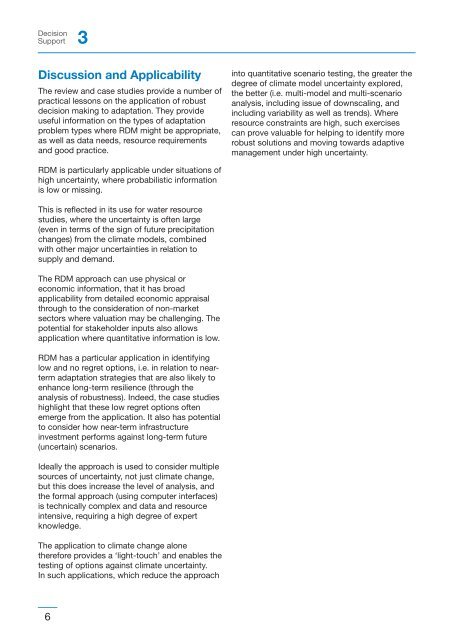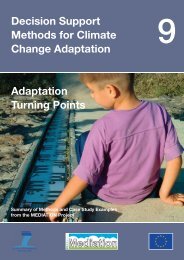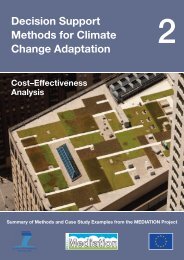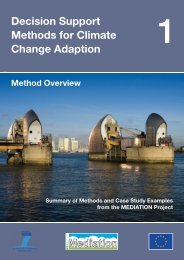Download all Technical Policy Briefing Notes in a single ... - Mediation
Download all Technical Policy Briefing Notes in a single ... - Mediation
Download all Technical Policy Briefing Notes in a single ... - Mediation
- No tags were found...
You also want an ePaper? Increase the reach of your titles
YUMPU automatically turns print PDFs into web optimized ePapers that Google loves.
DecisionSupport 3Discussion and ApplicabilityThe review and case studies provide a number ofpractical lessons on the application of robustdecision mak<strong>in</strong>g to adaptation. They provideuseful <strong>in</strong>formation on the types of adaptationproblem types where RDM might be appropriate,as well as data needs, resource requirementsand good practice.<strong>in</strong>to quantitative scenario test<strong>in</strong>g, the greater thedegree of climate model uncerta<strong>in</strong>ty explored,the better (i.e. multi-model and multi-scenarioanalysis, <strong>in</strong>clud<strong>in</strong>g issue of downscal<strong>in</strong>g, and<strong>in</strong>clud<strong>in</strong>g variability as well as trends). Whereresource constra<strong>in</strong>ts are high, such exercisescan prove valuable for help<strong>in</strong>g to identify morerobust solutions and mov<strong>in</strong>g towards adaptivemanagement under high uncerta<strong>in</strong>ty.RDM is particularly applicable under situations ofhigh uncerta<strong>in</strong>ty, where probabilistic <strong>in</strong>formationis low or miss<strong>in</strong>g.This is reflected <strong>in</strong> its use for water resourcestudies, where the uncerta<strong>in</strong>ty is often large(even <strong>in</strong> terms of the sign of future precipitationchanges) from the climate models, comb<strong>in</strong>edwith other major uncerta<strong>in</strong>ties <strong>in</strong> relation tosupply and demand.The RDM approach can use physical oreconomic <strong>in</strong>formation, that it has broadapplicability from detailed economic appraisalthrough to the consideration of non-marketsectors where valuation may be ch<strong>all</strong>eng<strong>in</strong>g. Thepotential for stakeholder <strong>in</strong>puts also <strong>all</strong>owsapplication where quantitative <strong>in</strong>formation is low.RDM has a particular application <strong>in</strong> identify<strong>in</strong>glow and no regret options, i.e. <strong>in</strong> relation to neartermadaptation strategies that are also likely toenhance long-term resilience (through theanalysis of robustness). Indeed, the case studieshighlight that these low regret options oftenemerge from the application. It also has potentialto consider how near-term <strong>in</strong>frastructure<strong>in</strong>vestment performs aga<strong>in</strong>st long-term future(uncerta<strong>in</strong>) scenarios.Ide<strong>all</strong>y the approach is used to consider multiplesources of uncerta<strong>in</strong>ty, not just climate change,but this does <strong>in</strong>crease the level of analysis, andthe formal approach (us<strong>in</strong>g computer <strong>in</strong>terfaces)is technic<strong>all</strong>y complex and data and resource<strong>in</strong>tensive, requir<strong>in</strong>g a high degree of expertknowledge.The application to climate change alonetherefore provides a ‘light-touch’ and enables thetest<strong>in</strong>g of options aga<strong>in</strong>st climate uncerta<strong>in</strong>ty.In such applications, which reduce the approach6





